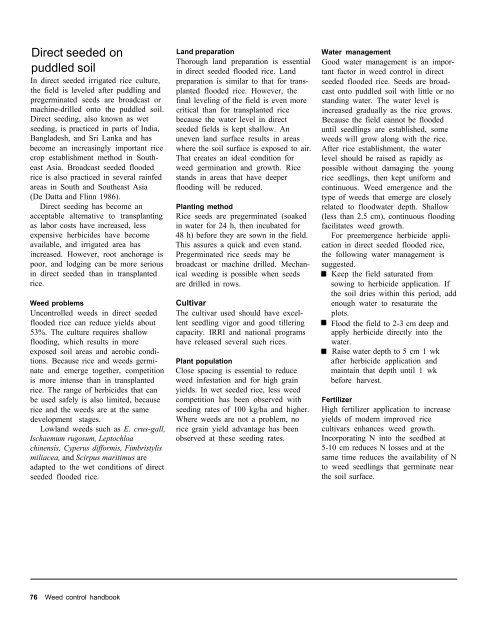A handbbok on Weed Control in Rice.pdf
A handbbok on Weed Control in Rice.pdf
A handbbok on Weed Control in Rice.pdf
Create successful ePaper yourself
Turn your PDF publications into a flip-book with our unique Google optimized e-Paper software.
Direct seeded <strong>on</strong><br />
puddled soil<br />
In direct seeded irrigated rice culture,<br />
the field is leveled after puddl<strong>in</strong>g and<br />
pregerm<strong>in</strong>ated seeds are broadcast or<br />
mach<strong>in</strong>e-drilled <strong>on</strong>to the puddled soil.<br />
Direct seed<strong>in</strong>g, also known as wet<br />
seed<strong>in</strong>g, is practiced <strong>in</strong> parts of India,<br />
Bangladesh, and Sri Lanka and has<br />
become an <strong>in</strong>creas<strong>in</strong>gly important rice<br />
crop establishment method <strong>in</strong> South-<br />
east Asia. Broadcast seeded flooded<br />
rice is also practiced <strong>in</strong> several ra<strong>in</strong>fed<br />
areas <strong>in</strong> South and Southeast Asia<br />
(De Datta and Fl<strong>in</strong>n 1986).<br />
Direct seed<strong>in</strong>g has become an<br />
acceptable alternative to transplant<strong>in</strong>g<br />
as labor costs have <strong>in</strong>creased, less<br />
expensive herbicides have become<br />
available, and irrigated area has<br />
<strong>in</strong>creased. However, root anchorage is<br />
poor, and lodg<strong>in</strong>g can be more serious<br />
<strong>in</strong> direct seeded than <strong>in</strong> transplanted<br />
rice.<br />
<strong>Weed</strong> problems<br />
Unc<strong>on</strong>trolled weeds <strong>in</strong> direct seeded<br />
flooded rice can reduce yields about<br />
53%. The culture requires shallow<br />
flood<strong>in</strong>g, which results <strong>in</strong> more<br />
exposed soil areas and aerobic c<strong>on</strong>diti<strong>on</strong>s.<br />
Because rice and weeds germ<strong>in</strong>ate<br />
and emerge together, competiti<strong>on</strong><br />
is more <strong>in</strong>tense than <strong>in</strong> transplanted<br />
rice. The range of herbicides that can<br />
be used safely is also limited, because<br />
rice and the weeds are at the same<br />
development stages.<br />
Lowland weeds such as E. crus-gall,<br />
Ischaemum rugosum, Leptochloa<br />
ch<strong>in</strong>ensis, Cyperus difformis, Fimbristylis<br />
miliacea, and Scirpus maritimus are<br />
adapted to the wet c<strong>on</strong>diti<strong>on</strong>s of direct<br />
seeded flooded rice.<br />
76 <strong>Weed</strong> c<strong>on</strong>trol handbook<br />
Land preparati<strong>on</strong><br />
Thorough land preparati<strong>on</strong> is essential<br />
<strong>in</strong> direct seeded flooded rice. Land<br />
preparati<strong>on</strong> is similar to that for trans-<br />
planted flooded rice. However, the<br />
f<strong>in</strong>al level<strong>in</strong>g of the field is even more<br />
critical than for transplanted rice<br />
because the water level <strong>in</strong> direct<br />
seeded fields is kept shallow. An<br />
uneven land surface results <strong>in</strong> areas<br />
where the soil surface is exposed to air.<br />
That creates an ideal c<strong>on</strong>diti<strong>on</strong> for<br />
weed germ<strong>in</strong>ati<strong>on</strong> and growth. <strong>Rice</strong><br />
stands <strong>in</strong> areas that have deeper<br />
flood<strong>in</strong>g will be reduced.<br />
Plant<strong>in</strong>g method<br />
<strong>Rice</strong> seeds are pregerm<strong>in</strong>ated (soaked<br />
<strong>in</strong> water for 24 h, then <strong>in</strong>cubated for<br />
48 h) before they are sown <strong>in</strong> the field.<br />
This assures a quick and even stand.<br />
Pregerm<strong>in</strong>ated rice seeds may be<br />
broadcast or mach<strong>in</strong>e drilled. Mechan-<br />
ical weed<strong>in</strong>g is possible when seeds<br />
are drilled <strong>in</strong> rows.<br />
Cultivar<br />
The cultivar used should have excel-<br />
lent seedl<strong>in</strong>g vigor and good tiller<strong>in</strong>g<br />
capacity. IRRI and nati<strong>on</strong>al programs<br />
have released several such rices.<br />
Plant populati<strong>on</strong><br />
Close spac<strong>in</strong>g is essential to reduce<br />
weed <strong>in</strong>festati<strong>on</strong> and for high gra<strong>in</strong><br />
yields. In wet seeded rice, less weed<br />
competiti<strong>on</strong> has been observed with<br />
seed<strong>in</strong>g rates of 100 kg/ha and higher.<br />
Where weeds are not a problem, no<br />
rice gra<strong>in</strong> yield advantage has been<br />
observed at these seed<strong>in</strong>g rates.<br />
Water management<br />
Good water management is an important<br />
factor <strong>in</strong> weed c<strong>on</strong>trol <strong>in</strong> direct<br />
seeded flooded rice. Seeds are broadcast<br />
<strong>on</strong>to puddled soil with little or no<br />
stand<strong>in</strong>g water. The water level is<br />
<strong>in</strong>creased gradually as the rice grows.<br />
Because the field cannot be flooded<br />
until seedl<strong>in</strong>gs are established, some<br />
weeds will grow al<strong>on</strong>g with the rice.<br />
After rice establishment, the water<br />
level should be raised as rapidly as<br />
possible without damag<strong>in</strong>g the young<br />
rice seedl<strong>in</strong>gs, then kept uniform and<br />
c<strong>on</strong>t<strong>in</strong>uous. <strong>Weed</strong> emergence and the<br />
type of weeds that emerge are closely<br />
related to floodwater depth. Shallow<br />
(less than 2.5 cm), c<strong>on</strong>t<strong>in</strong>uous flood<strong>in</strong>g<br />
facilitates weed growth.<br />
For preemergence herbicide applicati<strong>on</strong><br />
<strong>in</strong> direct seeded flooded rice,<br />
the follow<strong>in</strong>g water management is<br />
suggested.<br />
Keep the field saturated from<br />
sow<strong>in</strong>g to herbicide applicati<strong>on</strong>. If<br />
the soil dries with<strong>in</strong> this period, add<br />
enough water to resaturate the<br />
plots.<br />
Flood the field to 2-3 cm deep and<br />
apply herbicide directly <strong>in</strong>to the<br />
water.<br />
Raise water depth to 5 cm 1 wk<br />
after herbicide applicati<strong>on</strong> and<br />
ma<strong>in</strong>ta<strong>in</strong> that depth until 1 wk<br />
before harvest.<br />
Fertilizer<br />
High fertilizer applicati<strong>on</strong> to <strong>in</strong>crease<br />
yields of modern improved rice<br />
cultivars enhances weed growth.<br />
Incorporat<strong>in</strong>g N <strong>in</strong>to the seedbed at<br />
5-10 cm reduces N losses and at the<br />
same time reduces the availability of N<br />
to weed seedl<strong>in</strong>gs that germ<strong>in</strong>ate near<br />
the soil surface.











